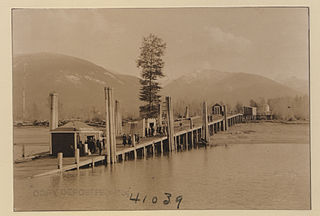Related Research Articles
The Nelson and Fort Sheppard Railway (N&FS) is a historic railway that operated in the West Kootenay region of southern British Columbia. The railway's name derived from a misspelling of Fort Shepherd, a former Hudson's Bay Company fort, on the west bank of the Columbia River immediately north of the border.

Salmo is a village in the West Kootenay region of southeastern British Columbia. It is mostly on the north side of Erie Creek at the confluence with the Salmo River. The place lies largely east of the junction of BC Highway 3, and BC Highway 6.

Ymir is a village in the Selkirk Mountains in the West Kootenay region of southeastern British Columbia. Ymir is located where the Salmo River meets Quartz Creek, and Ymir Creek. The locality, on BC Highway 6, is by road about 10 kilometres (6 mi) northeast of Salmo and 34 kilometres (21 mi) south of Nelson.

Montrose is in the West Kootenay region of southeastern British Columbia. The village lies 7 kilometres (4 mi) east of the city of Trail along Highway 3B.
Warfield is a village at the bottom of the Rossland hill, immediately west of Trail, in the West Kootenay region of southern British Columbia.

The Village of Slocan is in the West Kootenay region of southeastern British Columbia. The former steamboat landing and ferry terminal is at the mouth of Springer Creek, at the foot of Slocan Lake. The locality, on BC Highway 6 is about 69 kilometres (43 mi) by road north of Castlegar and 183 kilometres (114 mi) by road and ferry south of Revelstoke.
Raspberry is an unincorporated community in the West Kootenay region of southeastern British Columbia. On the northeast side of the Columbia River adjacent to the mouth of Norns Creek, the residential area is part of Greater Castlegar.

Corra Linn Dam is a concrete hydroelectric dam on the Kootenay River between the cities of Castlegar and Nelson, in the West Kootenay region of southern British Columbia.
Comaplix was a former mining town on the Incomappleux River in the Upper Arrow Lake area of the West Kootenay region of British Columbia. The name of the town and an adjacent mountain and creek derived from the river. Cleared in 1896, the town was surveyed and a sawmill established the next year. The suspicious 1915 fire, which levelled the buildings, largely ended the flourishing hamlet. The site, north of Beaton, on the northeast side of the lake's Beaton Arm, comprised merely concrete foundations when the Keenleyside Dam reservoir submerged the area in 1968. The small overgrown cemetery above the townsite is all that remains.

Beaton is at the head of the Beaton Arm of Upper Arrow Lake in the West Kootenay region of southeastern British Columbia. The locality is sometimes confused with nearby Evansport.
Brilliant is in the West Kootenay region of southeastern British Columbia. The locality is on the northeast side of the Columbia River, and on the west shore at the mouth of the Kootenay River. This minor residential area, west of Highway 3A, is part of Greater Castlegar.

Burton is a settlement on the east shore of Lower Arrow Lake in the West Kootenay region of southeastern British Columbia.
Ferguson is an unincorporated community in the West Kootenay region of southeastern British Columbia. The near ghost town is immediately northwest of the confluence of Ferguson Creek into Lardeau Creek. The locality, on Ferguson Rd and off BC Highway 31, is by road about 183 kilometres (114 mi) north of Nelson and 96 kilometres (60 mi) by road and ferry southeast of Revelstoke.
Pilot Bay is a on the east shore of Kootenay Lake in the West Kootenay region of southeastern British Columbia. The locality is about 6 kilometres (4 mi) south of Kootenay Bay on Pilot Bay Rd, immediately southwest of the entrance to Pilot Bay Provincial Park.
Lemon Creek is an unincorporated community on the east side of the Slocan River in the West Kootenay region of southeastern British Columbia. The locality is on BC Highway 6 about 8 kilometres (5 mi) south of Slocan, and 62 kilometres (39 mi) north of Castlegar.
Bonnington Falls is a community on the north side of the Kootenay River between the cities of Castlegar and Nelson, in the West Kootenay region of southern British Columbia. It was named after the adjacent Bonnington Falls, now submerged by hydro dams.
South Slocan is an unincorporated community in rural British Columbia with a population of approximately 100 people, many of whom are followers of the Doukhobors religion. It is located on the northwest shore of the Kootenay River in the West Kootenay region of southeastern British Columbia. The village comprises 51 households. A former railway junction on BC Highway 6, it is approximately 24 kilometres (15 mi) northeast of Castlegar, and 20 kilometres (12 mi) southwest of Nelson. Its postal category is Rural Route One.

The Boundary–Waneta Border Crossing connects the town of Northport, Washington with Trail, British Columbia on the Canada–US border. Access is via Waneta Road on the American side and British Columbia Highway 22A on the Canadian side.
Yoder is a Canadian ghost town in the West Kootenay region of southern British Columbia. The location, on BC Highway 3, is by road about 9 kilometres (6 mi) west of Salmo and 31 kilometres (19 mi) southeast of Castlegar.
References
- 1 2 3 "Nelson Star, 1 Apr 2017". www.nelsonstar.com. April 2017.
- ↑ "1897 BC Directory". www.bccd.vpl.ca.
- ↑ "Columbia Gardens (community)". BC Geographical Names .
- ↑ Basque Garnet (1982), British Columbia Ghost Town Atlas, Sunfire Publications
- ↑ "Trail Times, 29 Nov 2019". www.nelsonstar.com. 29 November 2019.
- ↑ "Nelson Star, 24 Nov 2013". www.nelsonstar.com. 24 November 2013.
- ↑ "St. Paul & Pacific Northwest Railroad: Washington map" (PDF). www.progressiverail.com.